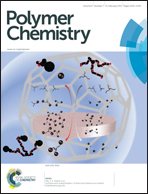A well-defined alternating copolymer based on a salicylaldimine Schiff base for highly sensitive zinc(ii) detection and pH sensing in aqueous solution†
Abstract
We herein report a new strategy to fabricate novel well-defined alternating copolymers of poly(VBCDEG-alt-SaAEMI)s which were synthesized via alternating RAFT copolymerization of para-methoxydiethylene glycol-substituted styrenes (VBCDEG) and N-(2-salicylaldehyde-aminoethyl)maleimides (SaAEMI). 1H NMR, 13C NMR, FTIR and GPC results indicate that poly(VBCDEG-alt-SaAEMI) copolymers have well-defined alternating structures and narrow polydispersity (Mw/Mn < 1.35). It is interesting that poly(VBCDEG-alt-SaAEMI) alternating copolymers exhibit an excellent selective fluorescence “OFF–ON” response to Zn2+ by inhibiting the photoinduced electron transfer (PET) effect through copolymerization, while the monomer SaAEMI almost has no fluorescence response to Zn2+ due to the PET process. The sensors based on poly(VBCDEG-alt-SaAEMI) alternating copolymers have very fast response (30 s) to Zn2+, 62-fold fluorescence enhancement in aqueous solution and a detection limit of about 0.25 μM. Additionally, the poly(VBCDEG-alt-SaAEMI) alternating copolymers also show a remarkable green fluorescence “OFF–ON” switch (230∼fold) when the pH turns from 11 to 12, thus these copolymers have potential application in dual-color detection.


 Please wait while we load your content...
Please wait while we load your content...